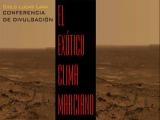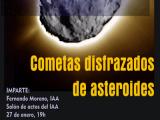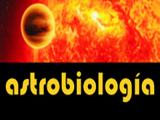Archivo de noticias y eventos
1501 - 1550 de un total de 2404
También puede acceder a la lista de noticias publicadas en los medios relacionadas con el Instituto de Astrofísica de Andalucía - CSIC.
Pages

|
28/04/2011 - 14:00
The connection between missing stellar cusps in galactic nuclei and general relativity One of the most interesting sources of gravitational waves is the inspiral of compact objects on to a massive black hole (MBH), commonly referred to as an extreme-mass ratio inspiral. The small object, typically a stellar black hole, emits significant amounts of GW along each orbit in the detector bandwidth. On the other hand, recent observations of the Galactic center revealed a dearth of giant stars inside the inner parsec relative to the... Pau Amaro Seoane |

|
14/04/2011 - 14:00
Discos de acreción alrededor de protoestrellas de masa alta e intermedia Las observaciones directas, que resuelvan angularmente los discos de acreción en torno a estrellas jóvenes de masa alta e intermedia son escasas. Presentaré los resultados de nuevas observaciones radiointerferométricas de alta resolución angular que, junto con nuestros modelos teóricos, revelan la presencia de discos de acreción en torno a dos estrellas en formación. En el caso de la... Mayra Osorio |

|
31/03/2011 - 19:00
El exótico clima marciano En esta conferencia se hace una enumaración de nuestro conocimiento actual sobre el clima marciano. Se analizan sus características, haciendo especial hincapié en los parecidos y diferencias con el clima terrestre. Francisco González Galindo |

|
24/03/2011 - 13:00
The dirty side of astronomy: carbonaceous dust Since the beginning of modern astronomy, dust has always been considered an obstacle on the path to understanding both nearby and far away phenomena. In this talk I will explain briefly the origin and the life-cycle of carbonaceous dust, introduce to new discoveries and old puzzles and eventually show how dust can be used as a powerful astronomical tool. Alessandra Candian |

|
22/03/2011 - 13:00
Analysis of chemical and dynamical processes in the Earth's Atmosphere with MIPAS data MIPAS is a Fourier transform limb emission mid-infrared spectrometer in Earth orbit. It provides spectrally resolved radiance profiles in the 4.15 to 14.6 mum spectral region from about 5 km up to 70 km (in its nominal mode) and up to 150 km in special observation modes. At IMK and IAA, we retrieve temperature and the distributions of up to 30 trace species from these data, which then are used to study chemistry and dynamics of the atmosphere... Gabi Stiller |

|
17/03/2011 - 13:00
Star formation at high-z: a stacking approach applied to mm-data Star formation is a key ingredient of the formation and evolution of galaxies. The associated dust emission has been observed up to very high-z. At mm wavelengths, this can be done thanks to the negative k-correction, which compensates the increasing luminosity distance. However, only the brightest sources can be detected with the present instruments, even with the early ALMA capabilities. Here we present a routine to perform stacking analysis... Roberto Decarli |

|
16/03/2011 - 16:00
Interferometría, ¿magia o ciencia? Desde las primeras observaciones en 1946, la técnica de la interferometría ha tenido un desarrollo exponencial, especialmente aplicado al estudio en radio del Universo. A pesar de tener un fundamento físico sencillo son muchas las complicaciones técnicas a las que hay que enfrentarse, convirtiendo estos telescopios en increíbles obras de ingeniería. Sin embargo los problemas técnicos quedan... Rubén Herrero Illana Sala de Juntas del Instituto de Astrofísica de Andalucía (IAA-CSIC) |

|
10/03/2011 - 13:00
El Centro Astronómico Hispano-Alemán: 2014-2018 y más allá El Observatorio de Calar Alto cuenta en estos momentos con tres telescopios opticos-infrarrojos y un conjunto de 11 instrumentos que cubren un gran rango de necesidades en distintos campos científicos, con una demanda desigual por parte de la comunidad astronómica. Comenzando con los datos adquiridos durante segundo semestre del 2010, a lo largo del 2011 se procederá a la apertura del archivo público del observatorio, con el objetivo de... David Barrado |

|
03/03/2011 - 13:00
A 2D Spectroscopy view of NGC 588 Most of today's stars were formed in high intensity episodes about 7-10 Gyr ago. However, at these redshifts both resolution and dimming effects make it difficult to study in detail the interaction of the gas, dust and newly formed stars. Giant H II regions in very nearby galaxies constitute their best local counterpart to address such a study. Here, I present an analysis of NGC 588, a GHIIR in M33, based on optical Integral Field Spectroscopy... Ana Monreal Ibero |

|
02/03/2011 - 16:00
Espectroscopía de Campo Integral (IFS) Los espectrógrafos de campo integral (IFS) son instrumentos que nos permiten un estudio espectral sobre un campo de visión bidimensional, es decir, análisis de cubos con 3 dimensiones: dos espaciales y una espectral. Su uso cada vez es más común pues permiten estudiar la morfología de objetos extensos y sus propiedades espectrales simultáneamente. En esta charla os contaré los... Alba Fernández Martín Sala de Juntas del Instituto de Astrofísica de Andalucía (IAA-CSIC) |

|
24/02/2011 - 19:00
Las Ciencia de la Tierra en la Antártida En esta conferencia se resumen las diferentes campañas científicas que España, y en concreto el Observatorio de San Fernando, ha realizado en el territorio antártico. Además, se ofrece una visión histórica del Observatorio de San Fernando en Cádiz, patrón oficial de tiempo en España. Fernando Belizón |

|
24/02/2011 - 13:00
Gravitational Wave Astronomy in the 21st Century The discovery of the binary pulsar PSR B1913+16 by Hulse and Taylor provided definite evidence of the existence of gravitational waves as predicted by Einstein's General Theory of Relativity. It also contributed to encourage the development of different gravitational wave detectors that was pioneered in the 60s by Joseph Weber. Presently, we have a world-wide network of ground detectors that is expected to achieve the first detections during the... Carlos F. Sopuerta |

|
23/02/2011 - 19:00
Todo es química también en 2012 La química forma parte de diaria de nuestras vidas. Desde la ropa que vestimos hasta los materiales que empleamos en todo tipo de acciones, e incluso los alimentos que ingerimos. El 2011 fue el Año Internacional de la Química - http://www.quimica2011.es/ - una celebración de esta ciencia fundamental Bernardo Herradon |

|
17/02/2011 - 13:00
The Physics and Philosophy behind Cosmic Time How far back in time can we have knowledge of the universe? Most cosmologists would agree that the physics describing the ‘material content’ of the universe becomes increasingly speculative the further we go back in time. By contrast, it is widely assumed that the concept of time itself – by virtue of the cosmological standard model – can be safely extrapolated sixty orders of magnitude back from the present to the Planck... Henrik Zinkernagel |

|
10/02/2011 - 13:00
A Magnetized Jet from a Massive Protostar Supersonic jets are observed to emerge from a wide variety of astrophysical systems, from young stellar objects (YSOs) to AGNs. Despite their different physical scales (from hundreds to billions of astronomical units), they have strong morphological similarities. However, it is yet unclear whether there is a universal mechanism that can explain the origin of all these jets. Theoretical models suggest that the magnetic field is a fundamental... Carlos Carrasco González |

|
03/02/2011 - 13:00
The Transneptunian Region and Clues about Planet Formation The Transneptunian belt is a reservoir of icy bodies in the outer reaches of our solar system. This region is believed to be the source of the Jupiter-Family Comets and is also thought to contain very pristine material, the leftovers of planet formation beyond the ice line. Therefore, the TransNeptunian Objects (TNOs) carry important information on how the solar system was formed, and can give plenty of details on the processes that were... José Luis Ortíz |

|
01/02/2011 - 13:00
The ESO VLT instrumentation: Technical overview The present talk emphasizes the most relevant challenges which have been overcome from engineering point of view in order to build the first generation of VLT instruments. Indeed, VLT instrumentation has meant an enormous leap into technical complexity with respect to existing instrumentation for 4m-class telescopes. How ESO has managed the design, procurement and installation of the VLT instrument suite is here presented, as well as the special... Jean-Louis Lizon |

|
27/01/2011 - 13:00
Substellar Objects in Nearby Young Clusters (SONYC): Towards an Unbiased Census SONYC, "Substellar Objects in Nearby Young Clusters", is an ongoing project to provide a complete census of the brown dwarf and planemo (free-floating objects with masses comparable to those of massive planets)population in nearby young clusters. The SONYC survey relies on extremely deep wide-field optical and near-infrared imaging and follow-up spectroscopy. We make use of Subaru, VLT, Gemini, CTIO, NTT, and Spitzer to probe the... Koraljka Muzic |

|
26/01/2011 - 16:00
CheFlet polar basis for astronomical data analysis We present a new method to decompose galaxy images. We have developed a polar orthonormal basis, built using Chebyshev rational functions to expand the radial coordinate, and Fourier series to represent the azimuthal component. The method can fit galaxies in a very compact way, including simultaneously most of the galaxy substructure and the extended wings of the galaxy profile. Some applications of this method are being developed: photometry... Yolanda Jiménez Teja Sala de Juntas del Instituto de Astrofísica de Andalucía (IAA-CSIC) |

|
24/01/2011 - 19:00
Cometas disfrazados de Asteroides En esta conferencia se abordan los aspectos más novedosos en la investigación de los cometas, desde su formación, composición, naturaleza, etc. Específicamente se marcan las diferencias entre cometas y asteroides. Fernando Moreno |

|
20/01/2011 - 13:00
Star formation at small galactic scales We present a study of the distribution of star, gas, and dust components in star-forming regions in nearby galaxies. The targets sample a wide range of luminosities and morphologies in order to study how the violent star formation influences the dust and gas distribution inside the star-forming regions. The analysis is based on the comparison of multi-wavelength data from theFar-Ultraviolet (GALEX) to the Infrared (SPITZER and HERSCHEL). Mónica Relaño |

|
13/01/2011 - 13:00
Observaciones de la atmósfera de Marte desde la Tierra Hoy día hay un renovado interés en realizar observaciones de Marte con instrumentación en Tierra de un modo sistemático. Y hacerlo, ademas, en el infrarrojo. La tarea no está exenta de dificultades, incluyendo la contaminación telúrica y el pequeño tamaño del planeta rojo. En este seminario resumiré algunas de las investigaciones que se llevan a cabo, en las que participamos, y que están encaminadas a explotar una de las ventanas infrarrojas... Miguel Ángel López Valverde |

|
11/01/2011 - 16:00
Sondeo de la alta atmósfera de Venus y Marte usando espectroscopía molecular en el IR La alta atmósfera de los planetas terrestres se caracteriza, entre otros aspectos, por sus bajas densidades y condiciones ópticamente delgadas a la radiación solar en el visible/UV. La única excepción son las bandas moleculares IR en la región espectral por encima de 2um por las cuales los procesos radiativos se hacen significativos. Por tanto, las observaciones IR constituyen una herramienta ú... Gabriella Gilli Sala de Juntas del Instituto de Astrofísica de Andalucía (IAA-CSIC) |

|
16/12/2010 - 13:00
El campo magnético en galaxias El campo magnético de una galaxia no es solamente importante porque nos proporciona un método de observación, sino también por sus efectos dinámicos. En el pasado se estudió el proceso v -> B pero cada vez se reconoce más el proceso B -> v , es decir el campo magnético ha dejado de ser una magnitud pasiva para influir activamente en el movimiento. La importancia del magnetismo galáctico afecta a determinadas estructuras y también... Eduardo Battaner |

|
09/12/2010 - 13:00
Galactic surveys of Planetary nebulae and their astrophysics: past present and future I will briefly review the PN phenomena and describe the power of these objects as probes of stellar evolution and Galactic evolution. I will address their use as potent kinematic tracers and their value as cosmological distance indicators. Finally I will review the recent major progress in discovery, distance determinations and elimination of mimics before touching on the future potential using multi-wavelength optical-MIR-radio data. Quentin Parker |

|
02/12/2010 - 13:00
Stellar Population Synthesis at the End of 2010 Recent developments in stellar evolution theory describing critical phases of this process (e.g. TP-AGB), and the availability of new libraries of theoretical and empirical stellar spectra allow us to build more complete and realistic population synthesis models than those in common use. I will discuss the application of these models to various problems of interest and will review those aspects that still require some amount of theoretical and... Gustavo Bruzual |

|
01/12/2010 - 16:00
Stelar Population Synthesis Models Las galaxias son sistemas formados por muchas poblaciones estelares diferentes. Cada una de estas poblaciones deja su registro fósil en el espectro de las galaxias que nos da información sobre el proceso de formación y evolución de las mismas. Los modelos de síntesis de poblaciones estelares son una herramienta imprescindible para hacer este tipo de estudios ya que son la única manera que tenemos de... Clara Cortijo Ferrero Sala de Juntas del Instituto de Astrofísica de Andalucía (IAA-CSIC) |

|
25/11/2010 - 19:00
Astrobiologia. Expectativas presentes y futuras La astrobiología es la disciplina científica que investiga la posibilidad de vida fuera de nuestro planeta tierra. En esta conferencia se enumeran los aspectos más básicos de esta ciencia como es el descubrimiento de los exoplanetas, hasta los avances más actuales y las expectativas de futuro. Enric Pallé |

|
25/11/2010 - 26/11/2010
2ª Reunión Española de Nucleos de Galaxias Activas Granada |

|
23/11/2010 - 13:00
Dark matter on department scale The direct detection of dark matter on Earth depends on its density and its velocity in the Solar neighbourhood. Unforunately, it is uncertain whether the dark matter distribution on the relevant physical scales (milliparsec) is homogeneous or not. Traditional N-body simulations cannot achieve the required resolution, so we have developed an ingenious method, able to achieve virtually any arbitrary resolution at almost no computational cost.... Daniele Fantin |

|
18/11/2010 - 13:00
Photometric Redshifts and Cosmology: ALHAMBRA, CLASH and the J-PAS Survey I start with a brief overview of photometric redshifts. I describe the new version of the Bayesian Photometric Redshift software, BPZ, and compare its performance with other public photo-z codes as EAZY or LePhare on datasets like COSMOS or ALHAMBRA. I also introduce two large cosmological projects which heavily rely on photometric redshifts: the MultiCycle Treasury "Clusters and Supernova with Hubble" project, and the Javalambre-PAU... Narciso Benítez |

|
17/11/2010 - 16:00
Cosmología fotométrica Se ahondará en los conceptos fundamentales de los "redshift-fotométricos" y se discutirá el papel que desempeña este tipo de herramientas en la cosmología moderna. Alberto Molino Benito Sala de Juntas del Instituto de Astrofísica de Andalucía (IAA-CSIC) |

|
11/11/2010 - 13:00
A new sample of faint blazars The available blazar samples were selected at relatively high limiting flux densities in the radio and X-ray band. Those samples have small sizes (30-50 objects) making it difficult to statistically derive parameters related to beaming effects. Moreover, the estimate of those parameters is based on bright and intrinsically luminous sources. A deeper, larger sample of blazars has been constructed by Perlman et al. (1998) and by Landt et al. (2001... Franco Mantovani |

|
04/11/2010 - 13:00
Mesospheric CO2 clouds on Mars: observations and study with a General Circulation Model Mesospheric CO2 clouds have been recently observed on Mars, providing important information about the temperatures and winds at the mesosphere, an atmospheric region characterized by the scarcity of observational records. These clouds only appear at particular geographical locations, altitudes above the surface, and times of the year, posing interesting questions about the processes that are at the origin of these clouds. We use a computational... Francisco González Galindo |

|
02/11/2010 - 16:00
El puzle de la atmósfera marciana Realizaremos una visión de la atmósfera de Marte desde las primeras interpretaciones al conocimiento cada vez más profundo desarrollado en las últimas décadas: desde su evolución, composición, perfil térmico, oscilaciones de masa y de temperatura, que fundamentalmente ha sido posible gracias a las misiones espaciales y al traslado de modelos teóricos ya testados en la atmó... Javier Ruiz Madrona Sala de Juntas del Instituto de Astrofísica de Andalucía (IAA-CSIC) |

|
29/10/2010
La misión SUNRISE desvela una inesperada actividad en el Sol La mayoría de los resultados procede del instrumento IMaX, el magnetógrafo diseñado y construido en España bajo la dirección del Instituto de Astrofísica de Canarias y en el que colabora el Instituto de Astrofísica de Andalucía (IAA-CSIC) |

|
28/10/2010 - 19:00
Un Universo Magnético De la mano de Antxón Alberdi entenderemos el concepto de Campo Magnético y especialmente su papel en todos los ambientes del Universo, desde el Sol hasta las galaxias. Antxón Alberdi |

|
28/10/2010 - 14:00
On the discovery of the Zeeman effect on the Sun and in the laboratory The origin of the discoveries, both on the Sun and in the laboratory, of the action of a magnetic field on spectral lines, the so-called Zeeman effect, is discussed. The talk embraces the period from 1866, the first date of which the speaker is aware of observed evidences about the widening of spectral lines in sunspots (as compared to those formed in the photosphere), until 1908, the year in which the magnetic field in sunspots is definitely... José Carlos del Toro Iniesta |

|
21/10/2010 - 14:00
Umbral dots: clues to the internal structure of sunspots Sunspots have been studied since the time of Galileo, but they still remain one of the most active research fields in solar physics. Especially, research on the fine structure of sunspots made great progress with the advent of the Hinode satellite and CRISP spectropolarimetry at the Swedish Solar Telescope on La Palma. Umbral dots (UDs) are tiny bright points observed in the umbra of sunspots. They are scientifically interesting because they... Hiroko Watanabe |

|
15/10/2010 - 14:00
The Euler Characteristic as a Measure of the Topology of Cosmic Reionization After giving basic information about what and how we know about the epoch of reionization, I will very briefly introduce the cosmic reionization simulations which I am analyzing. Next, the concepts of topology and, in more detail, the Euler Characteristic are introduced. Only after providing the audience with this necessary background, I will present some results from the analysis of our cosmic reionization simulations. Martina M. Friedrich |

|
08/10/2010 - 12:30
El Centro Astronómico Hispano-Alemán: futura instrumentación y operaciones El Observatorio de Calar Alto cuenta en estos momentos con tres telescopios ópticos-infrarrojos y un conjunto de 11 instrumentos que cubren un gran rango de necesidades en distintos campos científicos, con una demanda desigual por parte de la comunidad astronómica. A partir del segundo semestre del 2010 se procederá a la apertura del archivo público del observatorio, optimizando la producción científica. Además, se están desarrollando dos... David Barrado |

|
07/10/2010 - 14:00
Características Morfológicas de los Espectros y los Entornos de las Estrellas OB Tbd Nolan Walborn |

|
01/10/2010
Hallazgo fortuito del núcleo activo de la galaxia en proceso de fusión Arp 299-A La existencia del núcleo activo se predijo en 2003, pero el estudio de esta galaxia se ha centrado en sus intensos brotes de formación estelar y en su alta tasa de producción de supernovas |

|
30/09/2010 - 14:00
The Pipe Nebula: Primordial conditions of a quiescent molecular cloud We present the results of a new deep, near-infrared survey of the essentially starless Pipe Nebula, combining data from ESO, Calar Alto, and SPITZER telescopes, and the 2MASS survey. We use this new high sensitivity data set to construct dust extinction maps with spatial resolutions one order of magnitude smaller that the local Jeans Length. Our maps allowed us to determine the structure of the cloud down to and below the scale of dense pre-... Carlos Román Zúñiga |

|
21/09/2010
Se observan ecos de luz en torno a estrellas muy jóvenes Se trata de un fenómeno poco habitual provocado por la reflexión de los pulsos de luz de las estrellas en las partículas de polvo interestelar |

|
16/09/2010 - 14:00
Active Galactic Nuclei at parsec scales We present a representative SED for low-luminosity AGNs, built from high-spatial resolution data for the LINERs and faint Seyferts in the sample. This distribution differs from those of bright Seyferts and Quasars, suggesting that the internal structure of AGNs appears to be largely determined by the amount of energy released by the central engine. On the other hand, we present a multiwavelength study of the nuclear star-formation (~2.5kpc x 2.... Juan Antonio Fernández Ontiveros |

|
09/09/2010 - 14:00
GO-IRS: a new multi-object spectrograph for the GTC GO-IRS stands for "GTC Optical Intermediate Resolution Spectrograph". It is the answer of a big team of over 100 experienced researchers and engineers from the University of Florida, China and Spain to the recent call for new instrumentation for the 10.4 m Gran Telescopio Canarias (GTC). The GO-IRS main facts are: 1000 MOS fibres in a 15 arcmin circular field of view; 4x400 IFU fibres in the central 2 arcmin; resolution powers of R=20k... José Antonio Caballero |

|
06/09/2010 - 14:00
Fundamental Constants in Time and Space According to the standard model of particle physics, fundamental constants, at least their low-energy limits, should be independent of time and location. Many fundamental constants of physics and astronomy are well defined locally. However, this "constancy of constants'' may not necessarily hold over the largest spatial and temporal scales, which are inaccessible by geological or astronomical studies of nearby targets. Now, advances in... Christian Henkel |

|
06/09/2010 - 10/09/2010
http://ere2010.iaa.csic.es Granada |

|
06/09/2010
Más de 200 investigadores se reúnen en Granada para debatir sobre la gravedad Los Encuentros Relativistas Españoles (ERE 2010) son una serie anual de conferencias sobre gravitación y relatividad que comenzaron en 1977 y que cuentan con un significativo reconocimiento internacional |